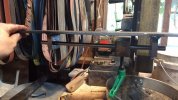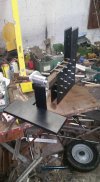- Joined
- Jul 31, 2015
- Messages
- 3,118
It lives!
The BladeForums.com 2024 Traditional Knife is available! Price is $250 ea (shipped within CONUS).
Order here: https://www.bladeforums.com/help/2024-traditional/
Yep, I just wanted to get everything aligned first. Thanks for the props!that turned out super awesome. definitely a project to be proud of, and the cam works beautifully. you might consider following AR's lead and run brass or bronze shims on the cam pivot. a shim between the upright and the tracking arm will smooth things out even more. if youre in a hurry you can substitute brass for plastic. the material from those cheap plastic folders works great.

Those are remnants from the original EERF plans and I believe as well that they are for a work rest. The two largest pieces are the work table and arm that would be bolted to the tool arm. I never could figure out how that was supposed to work. Regardless, since my revised version provides 2 tool arm slots, I just made a rest using a 1.5" square arm. It's 2 blocks (that I cut from the proposed work table piece) welded to a 3/8" plate for the table. Each piece has a 1/2" hole for a solid rod and set screw holes drilled and tapped to secure the rod in these blocks. The rod runs through a 1/2" hole in the solid 1.5" square tool arm for the rest. it can tilt forward and back and slide a lot side to side. I thought that might come in handy on long blades. Hope this helps.Kevin, can you take a couple photos showing what these pieces are for? I understand the top two are probably work rest somehow...?


thanks. Knife making has made me many times handier than I was previously. This is the ONE benefit that my wife can get behind!Cool stuff Kevin, nice work!
try it now..I appreciate all of the work that went into this, and I am sure there is 10x more that wme don't know about.
Thank you.
But, this leads to my question, is there a place where I can download the plans?
The two files in the OP are "trashed by the owner", or at least that is what the error I get says when I try to save or view them.
Those are remnants from the original EERF plans and I believe as well that they are for a work rest. The two largest pieces are the work table and arm that would be bolted to the tool arm. I never could figure out how that was supposed to work. Regardless, since my revised version provides 2 tool arm slots, I just made a rest using a 1.5" square arm. It's 2 blocks (that I cut from the proposed work table piece) welded to a 3/8" plate for the table. Each piece has a 1/2" hole for a solid rod and set screw holes drilled and tapped to secure the rod in these blocks. The rod runs through a 1/2" hole in the solid 1.5" square tool arm for the rest. it can tilt forward and back and slide a lot side to side. I thought that might come in handy on long blades. Hope this helps.
This is good information. I water jet cut mine. I assume the pieces in question are the long thin pieces with 4 holes each (6 of them) if you go with 1/4", you will need 12 of those, since they create the pocket for the tool arms( three- 1/2" spacers = 1.5" pocket). If you want to drill them, print out the PDF full scale and use those pieces from the print as a template for drilling. You MAY also be able to use steel tubes 11/2" long, 1/4" inside diameter and 1/2" outside diameter to use as spacers. You would need 12 of them.Ok cool, would it be possible to just delete these pieces from the file? Its not much but it is a few less inches of cutting which does reduce cost. I had this grinder cut out via laser a couple days ago a learned a few things. This is just my experience so it shouldn't be taken for gospel, other machines/processes may vary. Apparently, with laser you aren't supposed to cut holes where the diameter is less than the thickness of the material. It leaves a lot of slag, I think maybe due to heat build-up. Also, because of this heat build, a lot of my the long thin pieces came back warped. Cuts were not very clean. I really thought this would be good solution, but it was a little frustrating for me. I'm going to have them re-cut some pieces maybe in 1/4" instead of 1/2" and then just drill the holes instead of trying to pierce them. Annnnyway, just my .02!
the tracking mechanism hinge pin holes need to be drilled by hand anyway, as do the holes in the arm to attach the mechanism. I would just do those all by hand. I actually wound up slotting the holes in the mechanism that mount it to the arm, to give me some adjustment of the plane of the tracking wheel to the grinder body. This way, if your tapping of the tracking knob hole or the holes in the tracking arm are off (or anything else is off) you can get the tracking wheel back in plane. It takes very little angle at this piece to make a big difference in how it tracks. I imagine this is the same case for most grinders, and the reason the Reed products grinder has this type of adjustment built in. Oh, one thing on the build. I don't think i documented, but depending on your tool arm material, you may need to shim the tool arm pocket spacer with thin aluminum (like a beer can). I found on mine, that solid aluminum bars are a bit large for the pocket, and solid steel are a little small. I imaging this can't be helped with different tolerances for tool arm stock. I would recommend using solid aluminum and shimming, as the aluminum stock seems more consistent, and solid steel bar arms are HEAVY.Kevin, yeah I would double up the quantity on the 1/4" plates. And yes, you are correct about the problems being with the linear spacers. I hadn't considered using a tube type spacer but that is a good idea!
Kuraki, yeah that is the info I learned after the cut...! It seemed like he said they were using nitrogen for the diode cooling and oxygen in the cut. He also said that if I need him to recut the pieces he will just use the laser to etch the hole centers and then run them through the drill press.
The process really botched the tracking mechanism pieces as well so I'm just debating picking up the prefab OBM tracking mech of eBay.
Live and Learn!

